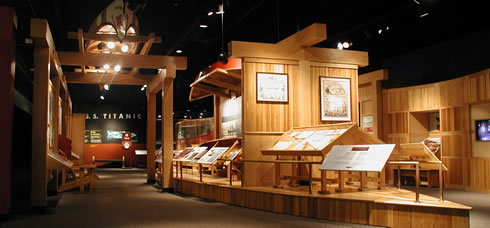
| Site Map | Français| Contact Us | Home | ||
 |
 |
Temporary Exhibitions
Mega Science
Visit our own celebration of the International Year of Physics. The Museum has developed a multiphase exhibit on several “Big Physics” projects in Canada. The Tokamak de Varennes, the Sudbury Neutrino Observatory, the founding of the Dominion Observatory, our Nobel prize-winning physicists, the ZEEP - Canada's first nuclear reactor - all are explained with the use of their own unusual artifacts. Tokamak - Creating the Sun on EarthCome and see our Canadian contribution to nuclear fusion, a possible future source of energy! The Tokamak de Varennes operated as a research device to study the confinement and heating of plasma, in the hope of achieving a working fusion reactor. Visitors are able to peek inside the Tokamak vacuum chamber, the vessel designed to bring plasma to fusion. Sudbury Neutrino ObservatoryDeep in a mine in northern Ontario, the Sudbury Neutrino Observatory counts tiny particles emitted by the Sun. Why? Our exhibit on this underground experiment will show you this amazing underground facility, and explain how it resolved the decades-old mystery about the inner workings of the Sun. Celebrating First Light A century years ago, the Dominion Observatory was founded at the Experimental Farm. Come and see the early telescopes and measuring instruments used to tell time and analyse the spectra of stars, including our Sun. Visitors can look through the original 15" refracting telescope from the Dominion Observatory during one of our astronomy programs given throughout the year. A century years ago, the Dominion Observatory was founded at the Experimental Farm. Come and see the early telescopes and measuring instruments used to tell time and analyse the spectra of stars, including our Sun. Visitors can look through the original 15" refracting telescope from the Dominion Observatory during one of our astronomy programs given throughout the year.
Nobel Prize-Winning PhysicistsZEEP - Canada's First Nuclear Reactor On September 5, 1945, ZEEP (Zero Energy Experimental Pile) sustained its first reaction, becoming the first nuclear reactor in the world outside the United States. Examine the original ZEEP calandria now on display, and find out how scientists first tested their theories of fission reaction 60 years ago. Inspect a model of Canada’s latest innovation in power generation, the Advanced CANDU Reactor. From power generation to isotope creation for medical diagnosis-- these benefits stem from early knowledge gained using this experimental nuclear reactor. On September 5, 1945, ZEEP (Zero Energy Experimental Pile) sustained its first reaction, becoming the first nuclear reactor in the world outside the United States. Examine the original ZEEP calandria now on display, and find out how scientists first tested their theories of fission reaction 60 years ago. Inspect a model of Canada’s latest innovation in power generation, the Advanced CANDU Reactor. From power generation to isotope creation for medical diagnosis-- these benefits stem from early knowledge gained using this experimental nuclear reactor.
Fading Away: Saving Your Electronic Memories
Press ReleaseCanoes: The Shape of SuccessWhat do M. Atwood, P.E. Trudeau. P. Johnson and Grey Owl have in common? They are all avid canoeists. This new exhibition takes visitors on a voyage of discovery. It explores the history of the commercial canoe in Canada, and how the success of this enterprise has helped make the canoe a universally recognized symbol of Canada. Electrifying an Ideal: Health and Beauty in the Home This unusual exhibition examines how our idea of beauty, as well as the tools we use to achieve 'the look', have changed over the past 150 years. The mini-exhibition features early electrical health apparatus, as well as electrical grooming gadgets dating from the second half of the 19th century to present day. Some of the advertisements that were used to market them are also featured. The museum is displaying many of these devices for the first time. This unusual exhibition examines how our idea of beauty, as well as the tools we use to achieve 'the look', have changed over the past 150 years. The mini-exhibition features early electrical health apparatus, as well as electrical grooming gadgets dating from the second half of the 19th century to present day. Some of the advertisements that were used to market them are also featured. The museum is displaying many of these devices for the first time.
The Centennial of the First Radio Broadcast: December 24, 2006 In December 1906, Canadian-born inventor Reginald Fessenden advised wireless operators on U.S. Navy and United Fruit Company ships to tune in on Christmas Eve for a special message. Shipping companies and navies had been using wireless telegraphy to communicate with their vessels at sea since the early 1900s and radio receivers built by Fessenden were standard equipment on board U.S. Navy and United Fruit Company ships. But that Christmas Eve operators who listened in did not hear the familiar dots and dashes of Morse code. Instead, to their great astonishment, a human voice came out of their receivers. In December 1906, Canadian-born inventor Reginald Fessenden advised wireless operators on U.S. Navy and United Fruit Company ships to tune in on Christmas Eve for a special message. Shipping companies and navies had been using wireless telegraphy to communicate with their vessels at sea since the early 1900s and radio receivers built by Fessenden were standard equipment on board U.S. Navy and United Fruit Company ships. But that Christmas Eve operators who listened in did not hear the familiar dots and dashes of Morse code. Instead, to their great astonishment, a human voice came out of their receivers.
|
| 2007 © Canada Science and Technology Museum Comments to: webmaster@technomuses.ca |




 A loaded Blattnerphone (690727) reel weighed 15 kg, 1933. (CSTM)
A loaded Blattnerphone (690727) reel weighed 15 kg, 1933. (CSTM)
